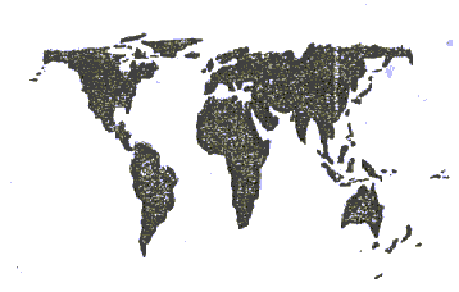

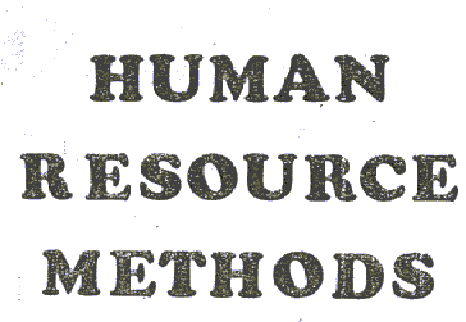
HUMAN RESOURCE METHODS
The Programmatic Chart 1
The Consult Method 2
The Art Form Conversation 3
The Workshop Method 5
Gridding 7
Creating a Timeline 9
Time Design 11
Space Design and Decor 13
Planning a Workday 15
Planning a Celebration 17
Keys to SingleCommunity
Development 19
Campaign ManeuverBuilding 21
programmatic chart not scanned
THE CONSULT PLANNING METHOD
The consult method is used either to launch a Human
Development Project or to assist any group to turn its vision
into reality. In this method contradictions are treated as doors
to the future rather than brick walls.
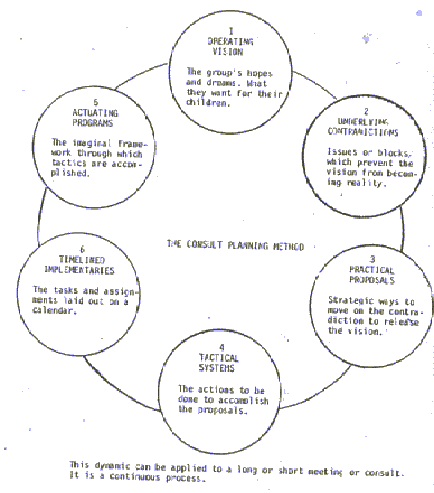 |
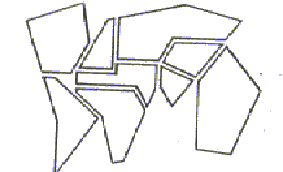
An art form is a tool for reflection. The art form
conversation is a series of questions that takes a group on a
journey of consciousness. This method is also useful for reflecting
on experiences such as the work of the morning, a village visit
or a celebration.
Very carefully, put your questions in the following order so that a journey in consciousness or awareness takes place. Not that all the following questions are right for every conversation. Choose or create questions right for the experience your conversation is about.
1. Objective: What did you see, hear, notice?
2. Reflective: What is your relation to the experience?
How did you feel?
What did you like? Dislike?
3. Interpretive: What is happening here?
Where do you see this going on in life?
Where in your life?
What story would you tell about it?
What would you name it?
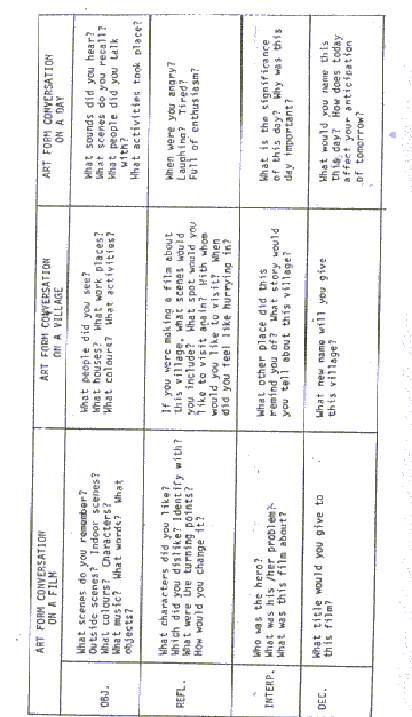 |
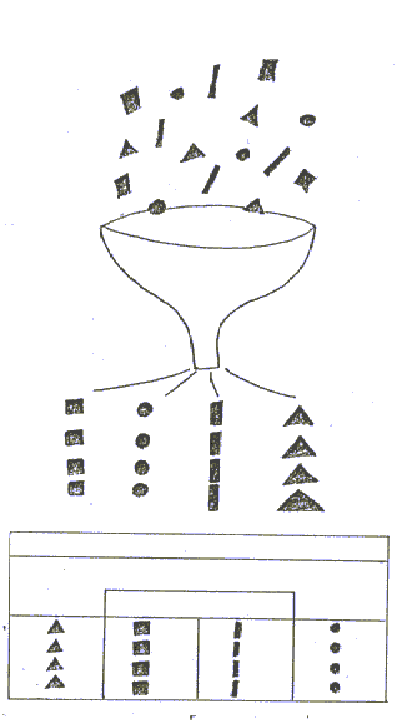
The workshop is a way for a group of people to pool
all the insights from its members on any issues, and then to give
fore, and direction to the data out of the consensus of the group.
It is a way to get everyone's wisdom into a new plan.
1. Context: Why do this work shop?
What is its topic?
What is its aim?
2. Brainstorm
Ask questions to which the answers will be brainstorm
in which everyone participates. Put the brainstorm 1ists on the
board. Honour all contributions. Each person's response should
be short no long speeches or argument.
3. Gestalt
Gestalt the lists that is, arrange data into
groups of related items . This gestalt may reveal areas where
more data is needed. Often it will reveal new relationships.
Name the gestalt. This clarifies the consensus of
the group up to this point, allowing the group to move forward
to create a model, such as a timeline, a graphic design or a chart.
5. Reflection
Reflection what you have done. What breakthroughs,
what insights have become clear. Reflector, the original issue
of the workshop and the work accomplished.
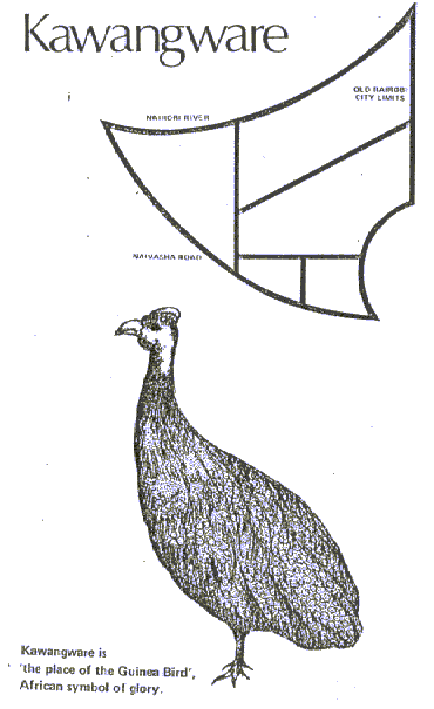
Gridding is a method which helps you to become familiar
with a piece of geography and what goes on within it its
sociality and then, to create an image or line picture
which holds this reality. It helps a group to form a consensus
about how it intends to relate to a particular area. For example,
how many stakes or neighborhoods are there, and where are they?
Where is the centre, or where should a centre be created? Where
do outsiders enter the community and how should that place be
created? The grid is the first symbolic and practical step in
taking responsibility for space by organizing it into rational
geographic patterns.
1. Become familiar with the geography to be gridded
(walk, drive, get population data, maps, etc.).
2. Art form the map of the area.
3. Identify and mark: population centers, cultural
or ethnic divisions, nodes j landmarks, natural boundaries (rivers,
lakes, etc.), political boundaries, arteries and pathways.
4. Discuss values to be used in gridding such
as population size, etc.
5. Draw initial picture of the area, share these
and discuss the gifts of each.
6. Form a consensus on the grid. Symbolic power is
the key and therefore, you want a grid that can be easily reproduced.
7. Check the grid against the economic and social
principles and actual data on the area.
Draw large artistic form of the grid and put it in
a highly visible public space.
Making a timeline creates a releasing image of how
a total task can be completed by showing the parts of the task
spread out over the time available. A timeline clearly lays out
what must be done at each stage to ensure that the model or plan
is implemented.
1. Start with the model or plan which has to be done.
2. Organize the tasks from the plan into arenas of
activity.
3. List the details of these tasks in each arena.
4. Decide how much time is needed for the entire
plan to be accomplished.
5. Draw a timeline chart with the arenas along the
left side and the time along the top. The timeline can be for
several years, several months, weeks or days, depending on the
work to be accomplished.
6. Decide which tasks come early, which late, and
put them in the appropriate space on the chart. .Post the chart.
7. Check the chart regularly and make any revisions that become necessary.
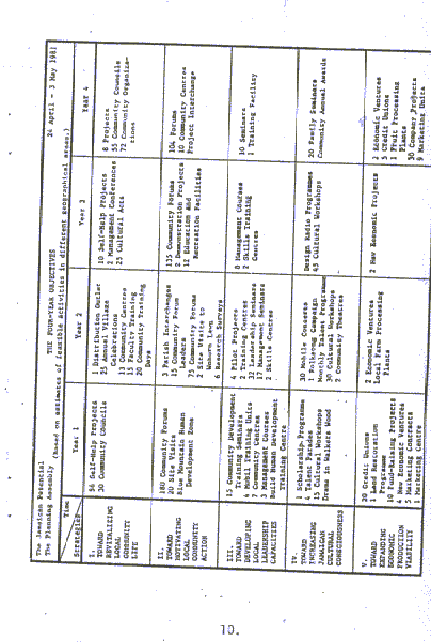
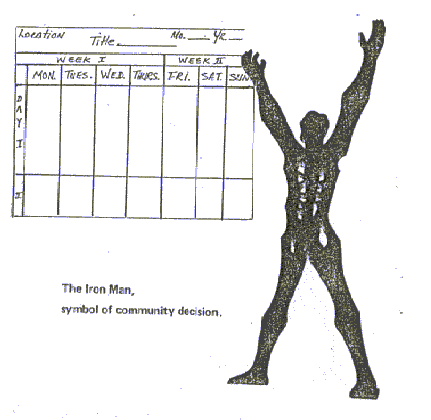
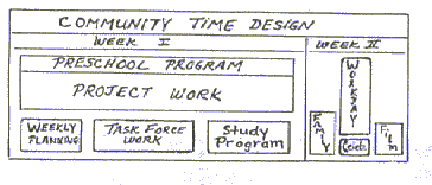
A time design puts an imaginal framework around a
period of time in order to claim daybyday activities
as significant. A time design gives meaning to the daily and weekly
rhythms of a community.
1. Brainstorm the activities of the day or week.
2. Weave them into an ordered sequence, paying attention
to the rhythm and the form of the day or week, e.g. when is the
time for celebration, for teamwork, for a community workday, family
events, etc.
3. Create the name, even a poetic phrase, that holds
a block of time and relates it to the whole design.
4. Design a visual image, chart or art form that
holds the time pattern.
5. Make up the design and display it. It can be made as a piece of attractive
decor.
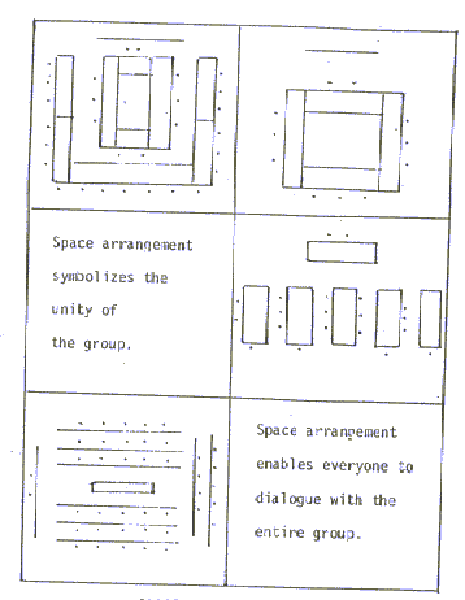
SPACE DESIGN AND DECOR
The space in which you lead a meeting or study or work affects you, although you may not be aware of it. Arrangement of the furniture in a room and the decor can turn neutral or negative space into an ally. Decor on the walls or tables steadily send messages that affect the images of those who live with them. It can create an environment of intentionality and victory, or of weariness and failure.
Taking care of space is an essential part of caring
for people.
1. For a corporate meal or meeting, arrange the tables
and chairs so that all the people can see each other and the front
of the room.
points so that everyone is easily served.
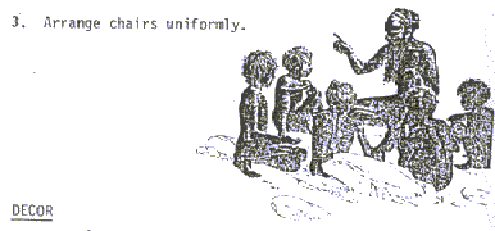
Decor claims space for a given purpose and sets a
context for the activities that take place in that space.
1. Design a focal point for the room by placing an
art form on the centre table.
2. Place wall decor at eye level.
3. Mount all wall decor on attractive backing
4. Hold both the global and the local in the decor.
Use symbolic decor and working decor, such as a timeline.
5. Make all charts attractive and rational. Never
post an unattractive chart.
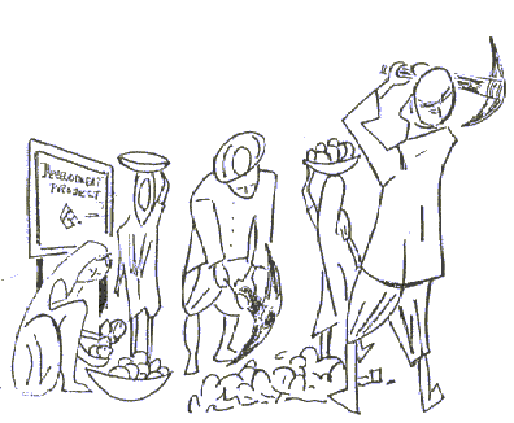
A corporate work event is a symbol of pouring out
your life into building community along with your neighbor. It
is creating a sign, changing an image, and demonstrating a new
possibility as it gets a job done. Sharing physical work and transforming
space forges corporateness and makes a lasting impression on those
who have a part in it.
1. Choose the task corporately, as a group.
Talk to people in all the stakes or neighborhoods
Talk to community leaders
Have a workshop Ask:
What needs to be done that can be done corporately
What will make a difference that all will notice?
What will engage all the troops for all the time?
(Think of twice as much work as you think you will
need.)
2. Context the troops.
The best context is to have the people who do the
work involved in the planning, but whether or not that happened,
find a way to share:
3. Prepare materials
Many workdays have almost sunk in the bog of forgotten
materials. Carefully brainstorm the materials you will need, and
by the morning before the day you need them, know where you will
get everything you need.
4. Answer these questions:
5. Celebrate the accomplishment. Take photographs, sing a song, do a ritual. Later reflect on the experience.
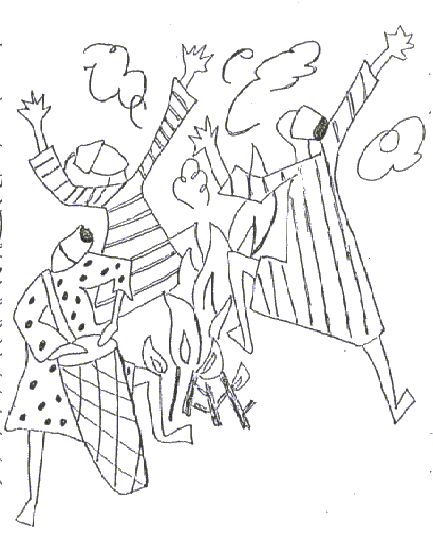
| WHY | What do you want to happen to people? (Everything else depends on that') | |
HOW | Mood
Theme
Activities
Space
Timing
Food
Music Budget | exuberant, calm, wild, delighted meditative, intriguing.
what ties it all together
singing, dancing, performing, eating, drinking, making things, contests, setup, cleanup
indoors, outdoors, familiar space, strange space, seating arrangements, lighting, col our, flowers, cloths. .
beginning, middle, end, transitions, high point, prelude.
type, how prepared and served, variety, theme . .
live, recorded, performed, equipment available resources, cost, how cost will be covered |
WHO | Roles Participants | assignment and contexting for host(s) and for those in charge of food, setup, etc. how they are to be invited, what image they will be given as to dress, how they will anticipate and remember the occasion with delight. |
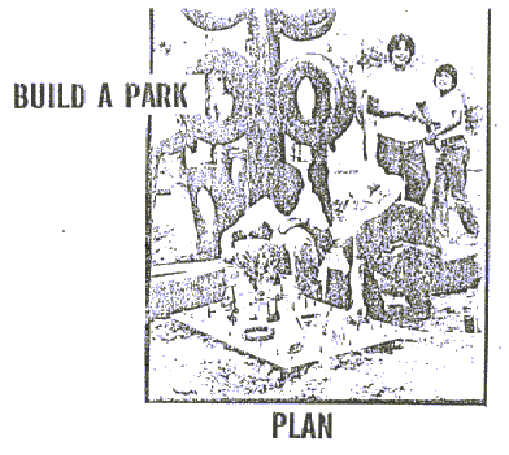
KEYS TO SINGLECOMMUNITY DEVELOPMENT
The Community Plans Together
The Community Works Together
The Community Invests Together
The Community Learns Together
The Community Celebrates Together
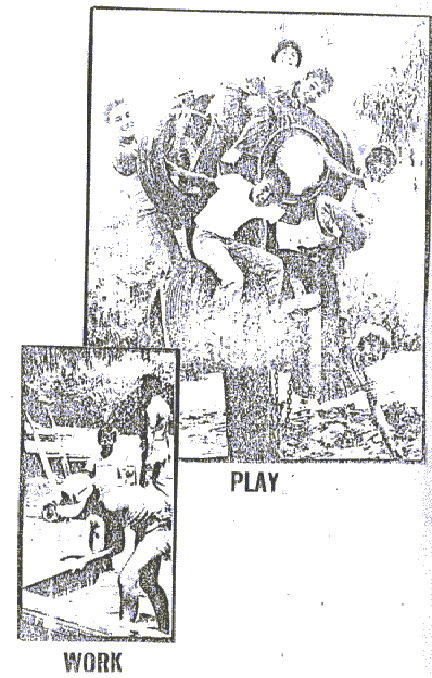
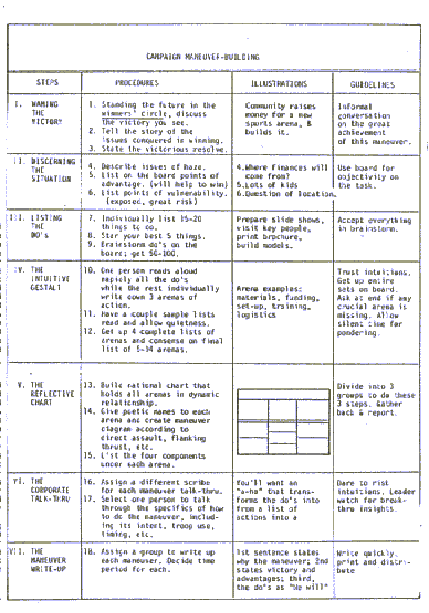
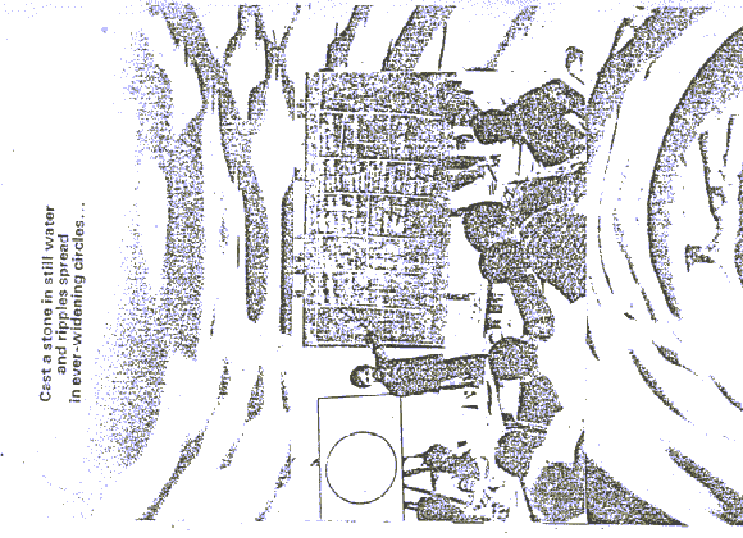
The Canadian Institute of Cultural Affairs is a voluntary
organization working for socioeconomic renewal. It is one of 35
nationally autonomous affiliates in developed and developing countries.
The uniqueness of ICA's approach is its emphasis
on human development on creating the desire and methods
whereby local people themselves plan and bring about lasting development
in their own communities.

THE CANADIAN INSTITUTE OF CULTURAL AFFAIRS
Montreal/Quebec Regions Toronto/London Regions Ottawa Region
5206 Ave. de l'Esplanade 99 Bellevue Avenue 121 Sherbrooke Ave.
Montreal, Quebec Toronto, Ontario Ottawa, Ontario
H21 2Z5 5T 2NB K1Y lS1
Tel. (514) 2761933 Tel. (416) 96129U9
Tel. (613)/236524